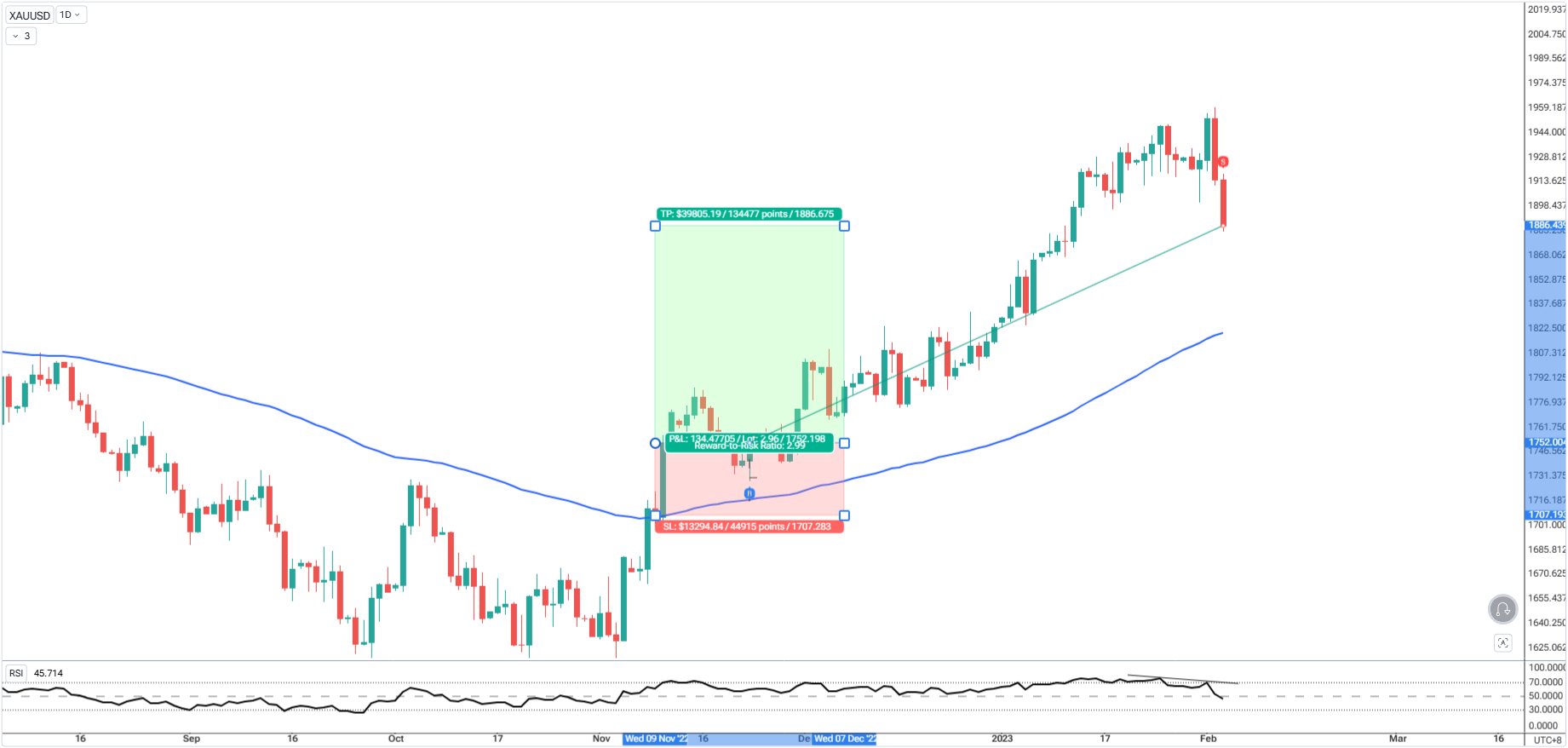
How Much Should You Risk per Trade? (1%, 2%, or Less?)
 ACY Securities - Jasper Osita
ACY Securities - Jasper OsitaGoal of This Lesson

To help traders determine the ideal amount of risk per trade and understand how compounding small gains creates sustainable long-term growth.
Basic Position Sizing Principles

1. Risking Too Much Creates Emotional and Financial Pressure
- Oversized positions magnify fear and greed.
- This leads to irrational decisions: cutting winners early, moving stops, or revenge trading.
- Small risk keeps you calm and allows you to focus on execution.
2. Compounding is the Path to Long-Term Growth
- Small, consistent returns compound exponentially.
- Example: a $10,000 account growing 2% per month compounds to $14,859 in 24 months.
- Over-risking may produce quick gains, but it also increases the chance of catastrophic losses that destroy compounding.
3. The Standard Benchmark: 1% per Trade
- Risking 1% of your total account balance per trade is a sustainable industry standard.
- $10,000 account → max $100 risk per trade.
- This lets you take multiple trades without risking your entire account.
4. Lower Risk if You’re New or Struggling
- Start with 0.5% or 0.25% if you’re still building consistency.
- This minimizes emotional stress and allows you to focus on the process, not just the outcome.
5. Adjust Risk as Your Account and Skills Grow
- Keep your risk percentage the same as your account grows. This is how you leverage compounding safely.
- Lower risk further during high-volatility news or uncertain conditions.
6. Higher Risk Does Not Mean Higher Profits
- Risking 5–10% per trade may create quick gains, but it also accelerates losses.
- One or two losing trades at this size can wipe out weeks or months of hard-earned growth.
Steps You Can Apply Now:

1. Calculate Your Risk in Dollars and Percentages
- Account balance × 1% = max loss per trade.
- Example: $5,000 account × 1% = $50 maximum loss per trade.
2. Base Your Position Size on Your Stop-Loss Distance
- Formula: PositionSize=Stop-Loss Distance (pips/points)Risk Amount
- Example: $50 risk ÷ 50 pips stop = $1 per pip.
3. Protect Your Compounding by Limiting Daily and Weekly Losses
- Max 1–1.5% risk per day and 5–6% per week.
- Compounding only works if you protect capital and avoid large drawdowns.
4. Review Past Trades to See if Your Risk is Too High
- If you feel pressure or can’t sleep after entering a trade, your risk is too large.
- Scale down until you can handle several consecutive losses without emotional breakdown.
Key Takeaway:

Trading is a game of survival and growth. Risk small, stay consistent, and allow compounding to do the heavy lifting.
By risking only a small percentage per trade, you protect your capital during losing streaks and set yourself up for exponential, sustainable growth over time.
Start Practicing with Confidence - Risk-Free!
Open a free demo account today and experience institutional-grade spreads, lightning-fast execution, and all the tools you need to grow as a trader.
- Trade forex, indices, gold, and more
- Access ACY, MT4, MT5, & Copy Trading Platforms
- Practice with zero risk
It’s time to go from theory to execution - risk-free.
Create an Account. Start Your Free Demo!
Check Out My Contents:
Strategies That You Can Use
How To Trade & Scalp Indices at the Open Using Smart Money Concepts (SMC)
How to Trade Breakouts Effectively in Day Trading with Smart Money Concepts
Complete Step-by-Step Guide to Day Trading Gold (XAU/USD) with Smart Money Concepts (SMC)
The Power of Multi-Timeframe Analysis in Smart Money Concepts (SMC)
Forex Trading Strategy for Beginners
Mastering Candlestick Pattern Analysis with the SMC Strategy for Day Trading
Mastering Risk Management: Stop Loss, Take Profit, and Position Sizing
How to Use Fibonacci to Set Targets & Stops (Complete Guide)
RSI Divergence Trading Strategy for Gold: How to Identify and Trade Trend Reversals
Stochastics Trading Secrets: How to Time Entries in Trending Markets using Stochastics
Gold Trading Stochastics Strategy: How to Trade Gold with 2R–3R Targets
RSI Hidden Divergence Explained: How to Spot Trend Continuations Like a Pro
How To Trade News
Why Smart Money Concepts Work in News-Driven Markets - CPI, NFP, and More
How to Trade NFP Using Smart Money Concepts (SMC)-A Proven Strategy for Forex Traders
How to Trade CPI Like Smart Money - A Step-by-Step Guide Using SMC
Learn How to Trade US Indices
How to Start Trading Indices and Get into the Stock Market with Low Capital (2025 Guide)
Best Indices to Trade for Day Traders | NASDAQ, S&P 500, DAX + Best Times to Trade Them
How To Trade & Scalp Indices at the Open Using Smart Money Concepts (SMC)
NAS100 - How to Trade the Nasdaq Like a Pro (Smart Money Edition)
How to Trade CPI Like Smart Money - A Step-by-Step Guide Using SMC
Why Smart Money Concepts Work in News-Driven Markets - CPI, NFP, and More
How to Start Trading Gold
How to Swing Trade Gold (XAU/USD) Using Smart Money Concepts: A Simple Guide for Traders
Complete Step-by-Step Guide to Day Trading Gold (XAU/USD) with Smart Money Concepts (SMC)
The Ultimate Guide to Backtesting and Trading Gold (XAU/USD) Using Smart Money Concepts (SMC)
Why Gold Remains the Ultimate Security in a Shifting World
How to Trade Japanese Candlesticks
How to Trade Candlestick Patterns with High Probability: A Complete Guide for Beginners
The Top Japanese Candlestick Guide: What is an Engulfing Pattern and How to Trade It?
Piercing Pattern Candlestick Explained: How to Trade It - Step-By-Step Guide
Morning & Evening Star Candlestick Patterns – How to Trade Market Reversals with Confidence
How to Start Day Trading
5 Steps to Start Day Trading: A Strategic Guide for Beginners
8 Steps How to Start Forex Day Trading in 2025: A Beginner’s Step-by-Step Guide
3 Steps to Build a Trading Routine for Consistency and Discipline - Day Trading Edition
The Ultimate Guide to Understanding Market Trends and Price Action
Trading with Momentum: The Best Trading Session to Trade Forex, Gold and Indices
Learn how to navigate yourself in times of turmoil
How to Identify Risk-On and Risk-Off Market Sentiment: A Complete Trader’s Guide
How to Trade Risk-On and Risk-Off Sentiment - With Technical Confirmation
The Ultimate Guide to Understanding Market Trends and Price Action
Want to learn how to trade like the Smart Money?
Why Smart Money Concepts Work: The Truth Behind Liquidity and Price Action
Mastering the Market with Smart Money Concepts: 5 Strategic Approaches
Mastering Candlestick Pattern Analysis with the SMC Strategy for Day Trading
Understanding Liquidity Sweep: How Smart Money Trades Liquidity Zones in Forex, Gold, US Indices
The SMC Playbook Series Part 4: How to Confirm Trend Reversal & Direction using SMC
The SMC Playbook Series Part 5: The Power of Multi-Timeframe Analysis in Smart Money Concepts (SMC)
Fair Value Gaps Explained: How Smart Money Leaves Footprints in the Market
The Best Time to Use Smart Money Concepts (SMC): Why Timing Is Everything in Trading SMC
How to Trade the London Session Using Smart Money Concepts (SMC)
Trading Psychology and Continuous Improvement Contents
The Mental Game of Execution - Debunking the Common Trading Psychology
5 Steps to Backtest a Trading Strategy with AI: A Step-by-Step Guide
Managing Trading Losses: Why You Can Be Wrong and Still Win Big in Trading
The Hidden Threat in Trading: How Performance Anxiety Sabotages Your Edge
Why You Fail in Trading: You Don’t Have Enough Capital to Survive
Why 90% of Retail Traders Fail Even with Profitable Trading Strategies
The Top 10 Best Trading Books That Changed My Mindset, Strategy & Performance
Discovering Your Trader Profile: What Kind of Trader Are You?
Follow me for more daily market insights!
Jasper Osita - LinkedIn - FXStreet - YouTube
This content may have been written by a third party. ACY makes no representation or warranty and assumes no liability as to the accuracy or completeness of the information provided, nor any loss arising from any investment based on a recommendation, forecast or other information supplies by any third-party. This content is information only, and does not constitute financial, investment or other advice on which you can rely.
LiquidityFinder
LiquidityFinder was created to take the friction out of the process of sourcing Business to Business (B2B) liquidity; to become the central reference point for liquidity in OTC electronic markets, and the means to access them. Our mission is to provide streamlined modern solutions and share valuable insight and knowledge that benefit our users.
If you would like to contribute to our website or wish to contact us, please click here or you can email us directly at press@liquidityfinder.com.
